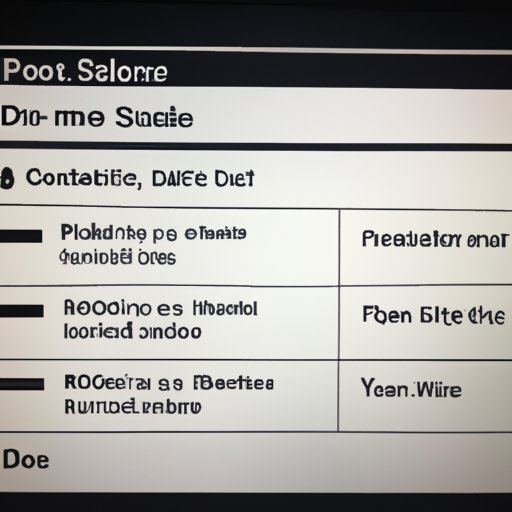Introduction
Starting your computer in Safe Mode is an important part of troubleshooting and diagnosing any issues that may be occurring with your computer. Safe Mode is a special mode of Windows operating system which allows you to access your computer with only basic functions and drivers enabled. By starting your computer in this mode, you can diagnose and repair various problems or errors without risking any further damage to your computer.
Press and Hold the F8 Key as Your Computer Starts Up
One of the most common ways to start your computer in Safe Mode is to press and hold the F8 key as your computer starts up. When your computer is powering on, you will see a “splash” screen that displays the manufacturer’s logo. You must press and hold the F8 key before this screen disappears, otherwise you will not be able to access Safe Mode. If you miss the window of opportunity, simply restart your computer and try again. Once you have successfully pressed and held the F8 key, you will be presented with a list of options, from which you should select “Safe Mode”.

Use System Configuration to Choose “Safe Mode” from the Boot Menu
Another way to start your computer in Safe Mode is to use the System Configuration utility (also known as msconfig). This utility can be used to change the startup settings on your computer, including the ability to choose which operating system you would like to boot into. To access the System Configuration utility, open the Run dialog box by pressing the Windows + R keys, then type “msconfig” and press Enter. In the System Configuration window, click on the “Boot” tab, then select “Safe Mode” from the list of available options.

Use Windows 10 Advanced Startup Options to Access Safe Mode
If you are using Windows 10, you can also use the Advanced Startup Options menu to access Safe Mode. To do this, open the Settings app (Windows + I) and click on the “Update & Security” option. From here, select the “Recovery” tab and then click on the “Advanced startup” option. This will open the Advanced Startup Options menu, where you can select “Safe Mode” from the list of available options.
Use the Shift + Restart Combination to Access Windows 10 Advanced Startup Options
Alternatively, you can use the Shift + Restart combination to access the Windows 10 Advanced Startup Options menu. To do this, press and hold the Shift key while clicking the “Restart” button in the Start menu. This will open the Advanced Startup Options menu, where you can select “Safe Mode” from the list of available options.
Use the System Configuration Utility to Set Safe Mode as the Default Startup Option
If you want to make sure that your computer always starts in Safe Mode, you can use the System Configuration utility to set Safe Mode as the default startup option. To access the System Configuration utility, open the Run dialog box by pressing the Windows + R keys, then type “msconfig” and press Enter. In the System Configuration window, click on the “Boot” tab, then select “Safe Mode” from the list of available options. Finally, click on the “Apply” button to save your changes.
Use the System Restore Feature to Roll Back Your Computer to a Time Before the Issue Occurred
If you are experiencing an issue with your computer and are unable to start it in Safe Mode, you can use the System Restore feature to roll back your computer to a time before the issue occurred. To access the System Restore feature, open the Run dialog box by pressing the Windows + R keys, then type “rstrui” and press Enter. This will open the System Restore window, where you can select a restore point from the list of available options.

Use a Windows Installation Disc or USB Drive to Access the Advanced Boot Menu and Select Safe Mode
If all else fails, you can use a Windows installation disc or USB drive to access the Advanced Boot Menu and select Safe Mode. To do this, insert your Windows installation disc or USB drive into your computer, then restart your computer. When you see the “splash” screen, press any key to boot from the disc or USB drive. This will open the Advanced Boot Menu, where you can select “Safe Mode” from the list of available options.
Conclusion
Starting your computer in Safe Mode is an important part of troubleshooting and diagnosing any issues that may be occurring with your computer. There are several different methods for starting your computer in Safe Mode, including pressing and holding the F8 key as your computer starts up, using the System Configuration utility to choose “Safe Mode” from the boot menu, using Windows 10 Advanced Startup Options, using the Shift + Restart combination to access Windows 10 Advanced Startup Options, using the System Configuration utility to set Safe Mode as the default startup option, using the System Restore feature to roll back your computer to a time before the issue occurred, and using a Windows installation disc or USB drive to access the Advanced Boot Menu and select Safe Mode.
(Note: Is this article not meeting your expectations? Do you have knowledge or insights to share? Unlock new opportunities and expand your reach by joining our authors team. Click Registration to join us and share your expertise with our readers.)
